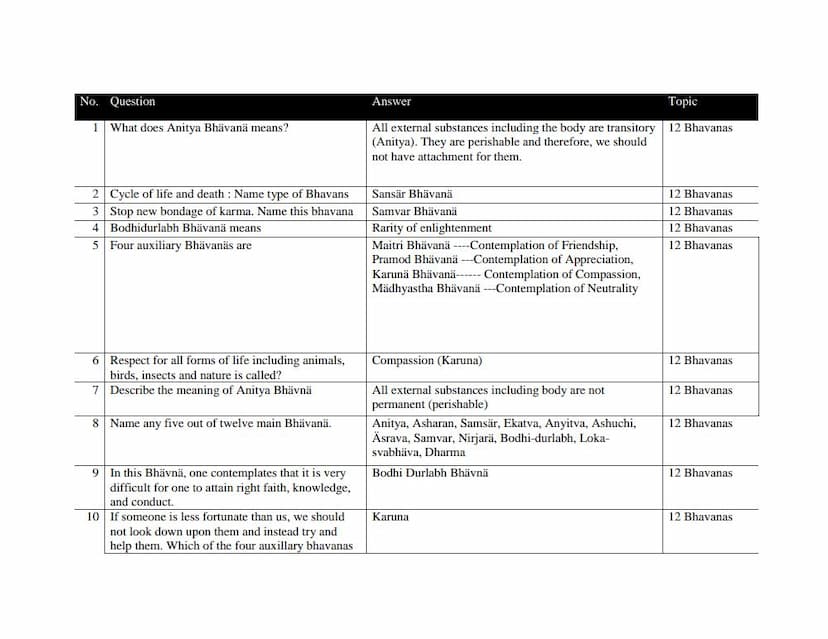JES 906 Jain Academic Bowl Past Q And A
Added to library: September 1, 2025
Loading image...

Summary
This document is a compilation of questions and answers from past Jain Academic Bowls, covering a wide range of topics within Jainism. The questions are categorized by topic, with "12 Bhavanas" and "24 Tirthankars" being prominent themes.
Here's a breakdown of the key areas covered and the general nature of the content:
Core Jain Concepts and Practices:
- Bhavanas (Contemplations): The document frequently tests knowledge about the 12 Bhavanas, including their meaning and specific examples. Key Bhavanas mentioned are Anitya Bhavana (impermanence), Samsara Bhavana (cycle of birth and death), Samvara Bhavana (stopping karma influx), Bodhi-durlabh Bhavana (rarity of enlightenment), Karuna Bhavana (compassion), and Asuchi Bhavana (impurity of the body). The four auxiliary Bhavanas (Maitri, Pramod, Karuna, Madhyastha) are also covered.
- Vows (Vratas): A significant portion of the text deals with the 12 Vows of Laity (Householders), detailing the Anuvratas (5 vows), Guna-Vratas (3 vows), and Shiksha Vratas (4 vows). Specific vows like Disha Pariman Vrat, Bhogopbhog Pariman Vrat, Anarthdand Virman Vrat, Samayik, Deshavagasik, Paushadh, and Atithi Samvibhag are explained. The difference between Mahavratas (for ascetics) and Anuvratas (for laypeople) is also addressed.
- Tattvas (Fundamentals): Several questions relate to the Nav Tattvas (Nine Fundamentals of Jainism), including Jiv, Ajiv, Punya, Pap, Ashrav, Samvar, Bandh, Nirjara, and Moksha. The concept of Heya (to be discarded), Gneya (to be known), and Upadeya (to be acquired) is discussed.
- Karmas: The document covers the 8 types of Karmas, including the 4 Ghati Karmas (knowledge-obscuring, perception-obscuring, deluding, and obstruction-causing) and the 4 Aghati Karmas (body-determining, lifespan-determining, status-determining, and name-determining). Subtypes of Karmas like Mohaniya and Vedniya are explored, as are concepts like Prakriti Bandh, Sthiti Bandh, Ras Bandh, and Pradesh Bandh.
- Dhyana (Meditation): The four types of Dhyana (Arta, Raudra, Dharma, and Shukla) are mentioned, with a focus on identifying good and bad types.
- Austerities (Tapas): Both internal and external austerities are discussed, including Anshan, Unodari, Vrutti Sankshep, Ras Tyag, Kayaklesh, Sanlinta, and the importance of Prayaschitta.
Tirthankaras and Jain History:
- 24 Tirthankaras: A substantial portion of the questions is dedicated to the lives, symbols (lanchan), parents, birthplaces, and nirvana places of the 24 Tirthankaras. Specific Tirthankaras like Rishabhdev, Ajitnath, Sambhavnath, Abhinandan, Sumatinath, Shantinath, Neminath, Parshvanath, and Mahavir Swami are frequently mentioned.
- Dreams of Mother Trishala: The document includes questions about the 14 dreams of Queen Trishala, indicating the auspicious nature of her son, the Tirthankara.
- Kalyanakas: The five auspicious events in a Tirthankar's life (Chyavana, Janma, Diksha, Kevalgyan, Nirvana) are covered.
- Acharyas and Saints: Key Jain Acharyas like Kundakundacharya, Hemchandracharya, Bhadrabahuswami, and Umaswami are discussed, along with their contributions and famous works.
- Sects and Traditions: The two main sects of Jainism, Shvetambar and Digambar, and their sub-divisions (Murtipujak, Sthanakvasi, Terapanthi, Bisapanth, Taranapanth) are mentioned.
Other Jain Topics:
- Six Universal Substances (Shad Dravya): Jiv, Ajiv, Dharmastikay, Adharmastikay, Akashastikay, and Kal are listed and explained.
- Leshya: The six types of Leshyas (Krishna, Neel, Kapot, Tejo, Padma, Shukla) and their associated qualities are covered, with a focus on the best and worst.
- Jain Symbols and Rituals: The meaning of symbols like the Swastika, the raised hand with "Ahimsa," and the chakra are explained. Temple rituals such as Puja, Nissihi, and the significance of various items used in worship are also discussed.
- Jain Scriptures: Important Jain texts like the Agams, Kalpa Sutra, Tattvartha Sutra, and various Angas and Upangas are mentioned.
- Jain Festivals: Major festivals like Paryushan, Dash Lakshana, Diwali, and Jnan Panchami are highlighted.
- Jain Principles: Concepts like Ahimsa Parmo Dharma, Parasparopagraho Jivanam, Anekantvad, and Syadvad are explained.
- Mathematical Problems: Some questions involve calculations based on the numbers of attributes, vows, or other Jain concepts to arrive at a Tirthankar's name or symbol.
Overall Purpose:
This document appears to be a valuable resource for anyone preparing for Jain quiz competitions, academic bowls, or simply seeking to deepen their understanding of Jainism. The question-and-answer format makes it an effective study tool for memorizing key facts, concepts, and terminology.